*NURSING > HESI MED SURG > HESI Case Study Nursing. Urinary Pattern. Notes, Questions Answers and Rationale. (All)
HESI Case Study Nursing. Urinary Pattern. Notes, Questions Answers and Rationale.
Document Content and Description Below
l Urinary Pattern - HESI Case Study Nursing. Urinary Pattern Meet the Client: Hunter Ellis Hunter Ellis, a 76-year-old African American male, is a resident in a long-term care facility. He ha... s been unable to control the urge to void since experiencing a stroke 1 month ago. He is alert and oriented and has no verbal deficits since his stroke. Physiologic Integrity 1. Mr. Ellis states that prior to his stroke, he would get up five or six times during the night to empty his bladder but that he was able to control the urge long enough to make it to the bathroom. How should the nurse describe the urinary pattern that Mr. Ellis is describing? A. Dysuria B. Frequency C. Nocturia D. Diureses Rationale: This refers to frequently voiding at night. The incidence of nocturia increases greatly in the older male client who has an enlarged prostate, or who may possibly indicate an inability to concentrate urine because of poor blood flow to the kidneys. 2. Since Mr. Ellis now voids spontaneously without recognizing the need to void, how should the nurse document his current urinary pattern in the medical chart? A. Polyuria B. Incontinence C. Retention D. Oliguria Safe and Effective Care Environment 3. To help manage Mr. Ellis' incontinence, the nurse initiates a bladder training program. Which instruction should the nurse provide to the unlicensed assistive personnel (UAP) who will be helping care for Mr. Ellis? A. Restrict oral fluids to 1,000 ml daily in evenly divided amounts. B. Offer warm coffee, cocoa, or tea every 2 hours while awake. C. Limit client socialization until voiding patterns are established. D. Remind the client to void every 2 hours while awake. 4. After several weeks, the bladder training program is unsuccessful in stopping Mr. Ellis' incontinence. Mr. Ellis appears withdrawn and states that he is frustrated at the number of episodes that he is having.Which nursing diagnoses are appropriate for Mr. Ellis? A. Fluid volume deficit related to voiding patterns. B. Fluid volume excess related to altered urination. C. Risk for uremic syndrome related to unresolved incontinence. D. Risk for impaired skin integrity related to urinary incontinence. E. Ineffective coping related to inability to control urine leakage. 6. Following an episode of incontinence, the nurse washes the client's perineal area with mild soap and water and applies a water-repellent ointment to the skin. Mr. Ellis' wife is present and the nurse uses this opportunity to educate her about proper skin care to prevent breakdown. Which of the following statements made by Mrs. Ellis indicates that teaching has been effective? a. "I should not apply lotions and ointments because it could increase the risk of skin breakdown" b. "Washing with mild soap and water followed by ointment can help to protect my husband's skin" c. "I should not use any type of soap on his buttocks or groin." d. "I should massage any reddened areas if I notice them." 7. The nursing staff continues with the bladder-training program, but Mr. Ellis' incontinence shows little improvement. Since the bladder training has not been successful, the nurse obtains a prescription to apply a condom catheter. Mr. Ellis is able to ambulate with assistance. In what order should the prescribed condom catheter be applied to Mr. Ellis? (Arrange the options in the order they should be performed with the first action on top and the last action on the bottom.) 1. clean and dry penis 2. apply skin cream 3. wrap adhesive spiral 4. place the rolled condom 5. attach a large leg drainage bag Rationale: Right order Safety and Infection Control 7. Mr. Ellis is admitted to the acute care facility for minor surgery. His preoperative prescriptions include the insertion of an indwelling urinary catheter. A student nurse is assigned to care for Mr. Ellis. The nursing instructor asks the student nurse to prepare to insert the indwelling catheter under supervision. What is the first step in the proper placement of an indwelling urinary catheter for a male client? a. Assemble the catheter, lubricant, and drainage receptacle b. advance the catheter on more inch (2.5cm) c. Gently insert and advance the catheter d. Wash the perineal area with soap and water. 8. The nurse reviews factors that may impact catheter insertion with the student nurse. Which physiologic change that commonly occurs in elderly males may affect insertion of the catheter? A. Prostate gland enlargement. B. Urethral stricture. C. Diminished bladder capacity. D. Weakened detrusor muscle. 9. The student obtains a 16 French Foley catheter from the supply room. The student nurse explains the procedure to Mr. Ellis, who gives permission to begin. After cleansing the urinary meatus, the student nurse maintains sterile technique while inserting the catheter into the urethra about 4 inches. While inflating the balloon, Mr. Ellis cries out in obvious pain. What action should the student nurse take? A. Reassure the client that the pain he is experiencing is only temporary. B. Tape the catheter to the client's abdomen to prevent further movement. C. Remove the catheter from the urethra immediately. D. Deflate the balloon, and insert the catheter farther. Documentation 10. The catheter is successfully placed in the bladder with a return of 200 mL of clear, yellow urine. The catheter is secured and Mr. Ellis is resting comfortably. In documenting the catheter insertion procedure, which statement should be included? A. No prostate gland enlargement noted during catheter insertion. B. 16 Foley catheter inserted with return of clear, yellow urine. C. 5 ml balloon inflated in the urethra but client is now comfortable. D. Indwelling catheter inserted because the client is incontinent. 11. Mr. Ellis returns from the Post Anesthesia Care Unit (PACU) after his surgical procedure. He has an IV of LR infusing at 125 mL/hr, O2 at 2 L/min per nasal cannula, and an indwelling catheter attached to a drainage bag. Four hours later, the nurse documents Mr. Ellis' intake/output. The LR solution has been running for 4 hours, and the nurse administers and IV antibiotic that runs in 150 mL of normal saline. Mr. Ellis is still NPO after the procedure. How does the nurse document Mr. Ellis' intake in mL? (Enter numerical value only. If rounding is necessary, round to the whole number?) 650 mL Rationale: 150 mL x 4 = 500 mL of LR. 500 mL + 150 mL (antibiotic) = 650 mL 12. Mr. Ellis is responsive but confused and frequently pulls on the urinary catheter. The nurse observes obvious hematuria in the drainage bag and notes the presence of several blood clots in the tubing. How should the nurse document this situation? A. Client does not know what he is doing, and he has caused bleeding to occur in the urine. B. Surgery caused client's confusion, resulting in pulling on the catheter and hemorrhage. C. Client is confused and pulls on the foley catheter. Urine is pinkish-red with blood clots. D. The client was instructed not to pull on his catheter, and now there is hematuria in the tubing. Reduction of Risk Potential 13. Mr. Ellis' hematuria continues. Two hours later, he becomes restless and appears to be in pain. The nurse observes that there has been no urinary output during the last 2 hours. Which assessment should the nurse complete first? A. Palpate for bladder distention. B. Obtain the blood pressure. C. Measure the oxygen saturation. D. Evaluate urinary drainage tubing 14. The nurse is unable to resolve the catheter obstruction using noninvasive measures and notifies the healthcare provider (HCP), who prescribes bladder irrigation to dislodge any blood clots obstructing the urine flow. The nurse anticipates that the prescription will include the use of which sterile solution to irrigate the catheter? A. Normal saline. B. Hydrogen peroxide. C. Heparinized saline solution. D. Chlorhexidine antimicrobial solution. 15. The RN encourages the student nurse to perform the irrigation. The student prepares the solution, applies gloves, clamps the distal tubing, and begins to clean the specimen port on the drainage tubing. What action should the nurse take? A. Encourage the student to continue, maintain aseptic technique. B. Instruct the student to instill 30 ml of air, followed by 30 ml of solution. C. Advise the student to leave the distal clamp in place for 30 minutes. D. Remind the student to empty the drainage bag before instilling the solution. 16. The student nurse instills a total of 60 mL of the correct solution and withdraws 40 mL of fluid containing several small blood clots. The student nurse then empties 200 mL from the urinary drainage bag. What urinary output should be recorded? (Enter the numerical value only. If rounding is required, round to the whole number.) 180 mL Rationale: The student instilled 20 ml more than was withdrawn, so that amount must be subtracted from the volume emptied from the drainage bag. 200 mL-20 mL=180mL The nurse may instill the irrigant without withdrawing any fluid. In that circumstance the entire amount of the irrigant must be subtracted from the amount of fluid emptied from the drainage bag to obtain an accurate measurement of the client's output. Safe and Effective Care Environment 17. During the catheter irrigation, the nurse observes that Mr. Ellis is still confused and attempts to pull at his urinary catheter, his IV, and his nasal cannula. The nurse considers the use of wrist restraints on the basis of which rationale? A. The client is confused. B. The client just had surgery. C. The client is at risk for self-injury. D. There is no family member present to stay with the client. 18. The nurse notifies the HCP and obtains a prescription for wrist restraints. The nurse applies the restraints and plans to monitor the client every 30 minutes. Which assessments are most important for the nurse to perform at each of these times? A. Skin integrity and pulse volume of the restrained extremities B. Auscultation of bilateral breath sounds and heart sounds. C. Vital signs and oxygen saturation via pulse oximetry. D. The presence and integrity of all invasive tubes. E. Pulse rate and volume in the wrists (including pulse volume, color, warmth, and sensation) must be assessed every 30 minutes, and the restraints removed at least every 2 hours to allow for ROM. Physiologic Adaptation 19. Mr. Ellis' confusion decreases, and 12 hours later the nurse is able to remove the wrist restraints. By the third postoperative day, no further hematuria or blood clots are observed in Mr. Ellis' urine. However, the nurse does observe that the urine has developed a cloudy appearance. Which action should the nurse implement? 18. Which should the nurse implement? A. Assess the client's skin turgor. B. Continue the catheter irrigations. C. Obtain a sterile urine specimen. D. Palpate the bladder for distention. Rationale: Urine develops a cloudy appearance when a urinary tract infection has developed. A sterile specimen is needed to detect and ID microorganisms. 20. Urinalysis results are: pH 8.5 Specific gravity 1.015 Protein none Glucose none WBCs 8 RBCs 2 Bacteria present Based on the urinalysis results, the HCP prescribes a broad-spectrum antibiotic. After 24 hours of receiving the antibiotic, Mr. Ellis’ condition has not improved. What additional nursing intervention will the nurse implement? A. Encourage the intake of high-protein foods. B. Offer additional high-carbohydrate snacks. C. Reduce the client's water intake. D. Provide a glass of cranberry juice daily. 21. Which diagnostic test result would make the nurse concerned that the client is at risk for sepsis? A. Serum creatinine and BUN are both elevated above normal. B. Urine culture shows resistance to the prescribed antibiotic. C. Partial thromboplastin time (PTT) is excessively prolonged. D. CBC shows low hemoglobin and hematocrit levels. Pharmacological and Parenteral 22. After reviewing Mr. Ellis' diagnostic test results, the nurse consults with the HCP and receives a prescription for a new antibiotic. Since Mr. Ellis' creatinine level is elevated, the nurse is concerned about which problem in administering the medication? A. Drug toxicity due to reduced drug excretion. B. Decreased effectiveness due to poor absorption. C. Altered first-pass effect due to reduced liver function. D. Increased free drug molecules due to low albumin levels. 23. The nurse notes that the medication dosage is in the safe range for elderly clients, which is to be administered by IV every 12 hours. The nurse recognizes that the frequency of drug administration is based on which characteristic of the medication? A. Bioavailability. B. Protein binding. C. Therapeutic index. D. Half-life. Base Care and Comfort 24. Mr. Ellis' indwelling catheter is removed by the nurse on the morning of Mr. Ellis' anticipated discharge. The nurse instructs the UAP to report if Mr. Ellis has not voided within how many hours? (Enter numerical value only. If rounding is necessary, round to the whole number.) 8 hours Rationale: Generally, if the client has not voided within 6 to 8 hours of catheter removal, further action should be taken. That may include reinserting a catheter. 25. To encourage voiding, the RN instructs the UAP to perform what intervention? A. Apply firm pressure to the bladder for 2-3 minutes. B. Turn on the tap so water is running when the client attempts to void. C. Place the client's hands in a basin of ice cold water. D. Place the client in a left lateral Sim's position. Pharmacological and Parenteral Therapies 26. Mr. Ellis voids after the catheter is removed and he is discharged from the acute care facility and transferred to the long-term care facility. Since he no longer has an IV, the prescription for his antibiotic is changed to an oral medication. Mr. Ellis has some difficulty swallowing (dysphagia), and the nurse is considering the best technique to help Mr. Ellis swallow the medication. Before deciding to open the capsule and mix it with food, what will the nurse need to determine? A. Is the capsule scored for ease of opening? B. Was Mr. Ellis able to swallow the capsules prior to his stroke? C. Is the medication in extended-release form? D. Does the medication come in unit dose packaging? 27. The nurse consults with the pharmacist, who determines that the capsule can be opened and mixed with a food that the client likes. Which technique should the nurse use? A. Crush the capsule and mix with applesauce. B. Open the capsule and mix the medication with pudding. C. Dissolve the capsule in a glass of warm milk. D. Open the capsule and mix in a glass of fruit juice. Psychosocial Care 28. Mr. Ellis' incontinence continues. Use of the condom catheter is resumed until Mr. Ellis develops localized dermatitis. The condom catheter is removed temporarily to promote healing, and although the nursing staff takes Mr. Ellis to the bathroom every 2 hours, he occasionally wets his clothing. The nurse enters Mr. Ellis' room and finds him crying. What is the best initial response by the nurse to this behavior? A. Leave Mr. Ellis alone until his crying subsides. B. Assign a UAP to sit with Mr. Ellis. C. Acknowledge to Mr. Ellis the distress that he is experiencing. D. Provide a distraction, such as turning on the television. 29. When Mr. Ellis is calm, the nurse assigns the UAP to help him into dry clothing. Several minutes later, the nurse walks down the hall and sees the UAP in the room changing Mr. Ellis' clothes. The nurse enters the room and assesses the situation. Which aspect of the situation requires the nurse's most immediate intervention? A. The room temperature seems excessively warm. B. A soap opera is playing loudly on the TV. C. A second UAP is watching the TV rather than helping. D. Mr. Ellis’ room door is open to the hallway. Case Outcome Mr. Ellis continues to reside at the long-term care facility. While his incontinence continues, the use of the condom catheter and other nursing interventions make it possible for him to enjoy daily activities and socialize with other residents. Diagnostic Cues for Urinary Incontinence: Assess a client for urinary incontinence in the presence of the following: • A wet bed or wet undergarments • An odor of urine • Report of incontinence • Membership in a group at high-risk for incontinence, such as women after menopause, older adults, or the neurologically impaired Assess a client for urinary retention in the presence of the following: • Complaint of a full bladder but inability to void • Complaint of difficulty starting the urine stream • Risk factors for acute retention and absence of voiding in 6 to 8 hours • Membership in a group at high-risk for retention, such as those with recent pelvic surgery, difficulty voiding, or anticholinergics use The Steps of Prompted Voiding Descriptions of Observations Closed Bladder Irrigation Tips for Preventing Infection in Catheterized Clients: Follow good hand-hygiene techniques. Do not allow the spigot on the drainage system to touch a contaminated surface. Only use sterile technique to collect specimens from a closed drainage system. If the drainage tube becomes disconnected, do not touch the ends of the catheter or tubing. Wipe the end of the tubing and catheter with an antimicrobial solution before reconnecting. Ensure that each client has a separate receptacle for measuring urine to prevent cross contamination. Prevent pooling of urine in the tubing and reflux of urine into the bladder. Avoid raising the drainage bag above the level of the bladder. If it becomes necessary to raise the bag during transfer of the client to a bed or stretcher, clamp the tubing or empty the tubing contents to the drainage bag first. Provide for drainage of urine from the tubing to the bag by positioning the tubing. Before exercise or ambulation drain all urine from the tubing into the drainage bag. Avoid prolonged kinking or clamping of the tubing. Empty the drainage bag at least every 8 hours. If large outputs are noted, empty more frequently. Encourage fluid intake (if not contraindicated). Inclusion of cranberry juice has been shown to decrease the adherence of bacteria to the bladder wall and to catheter lumen (Gray, 2002). Remove the catheter as soon as clinically warranted (Kunin, 2001). Tape or secure the catheter appropriately for the client. Perform routine perineal hygiene per agency policy and after defecation or bowel incontinence. Common Forms for Drug Preparations [Show More]
Last updated: 1 year ago
Preview 1 out of 13 pages
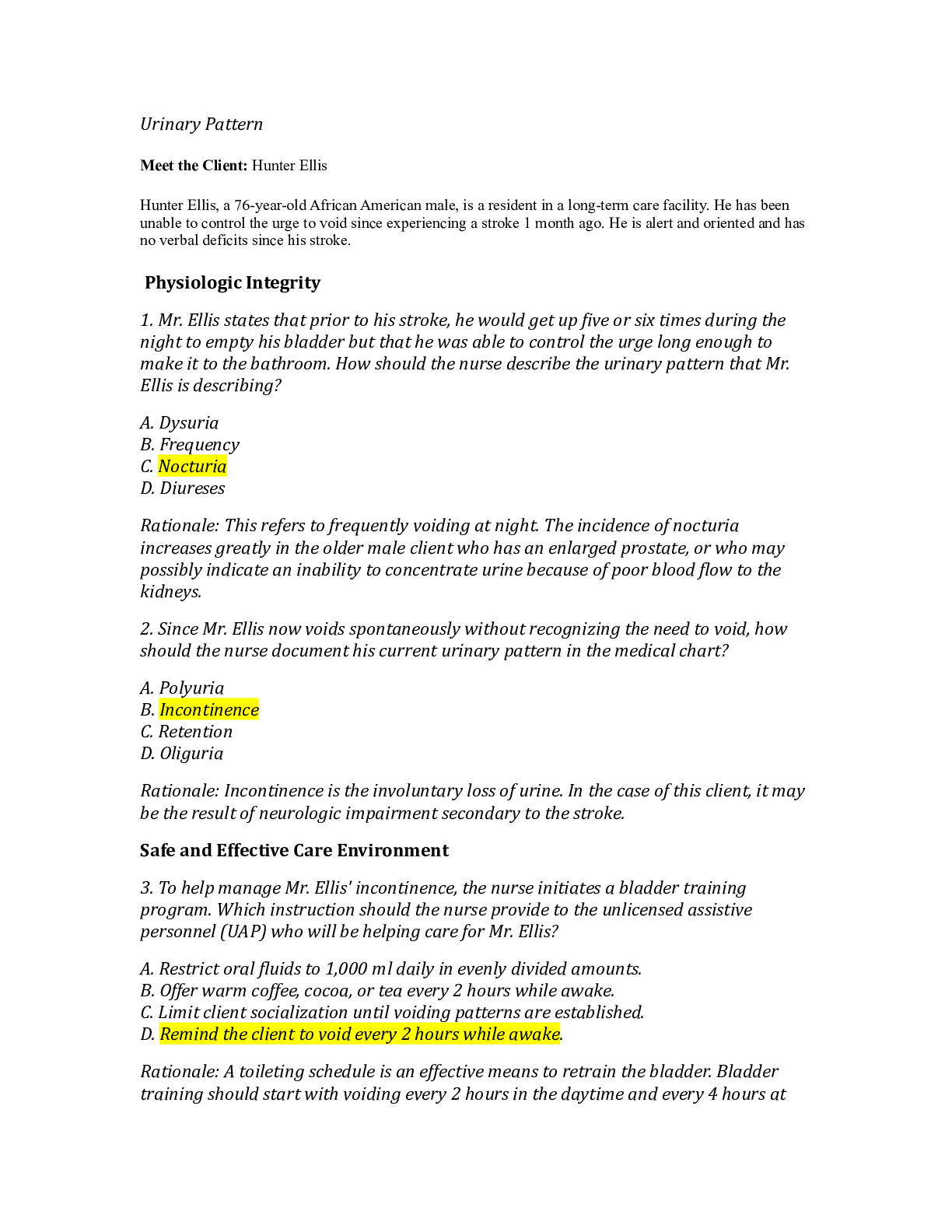
Reviews( 0 )
Recommended For You
*NURSING> HESI MED SURG > HESI PN Med Surge Exam | Questions and Answers | (All)
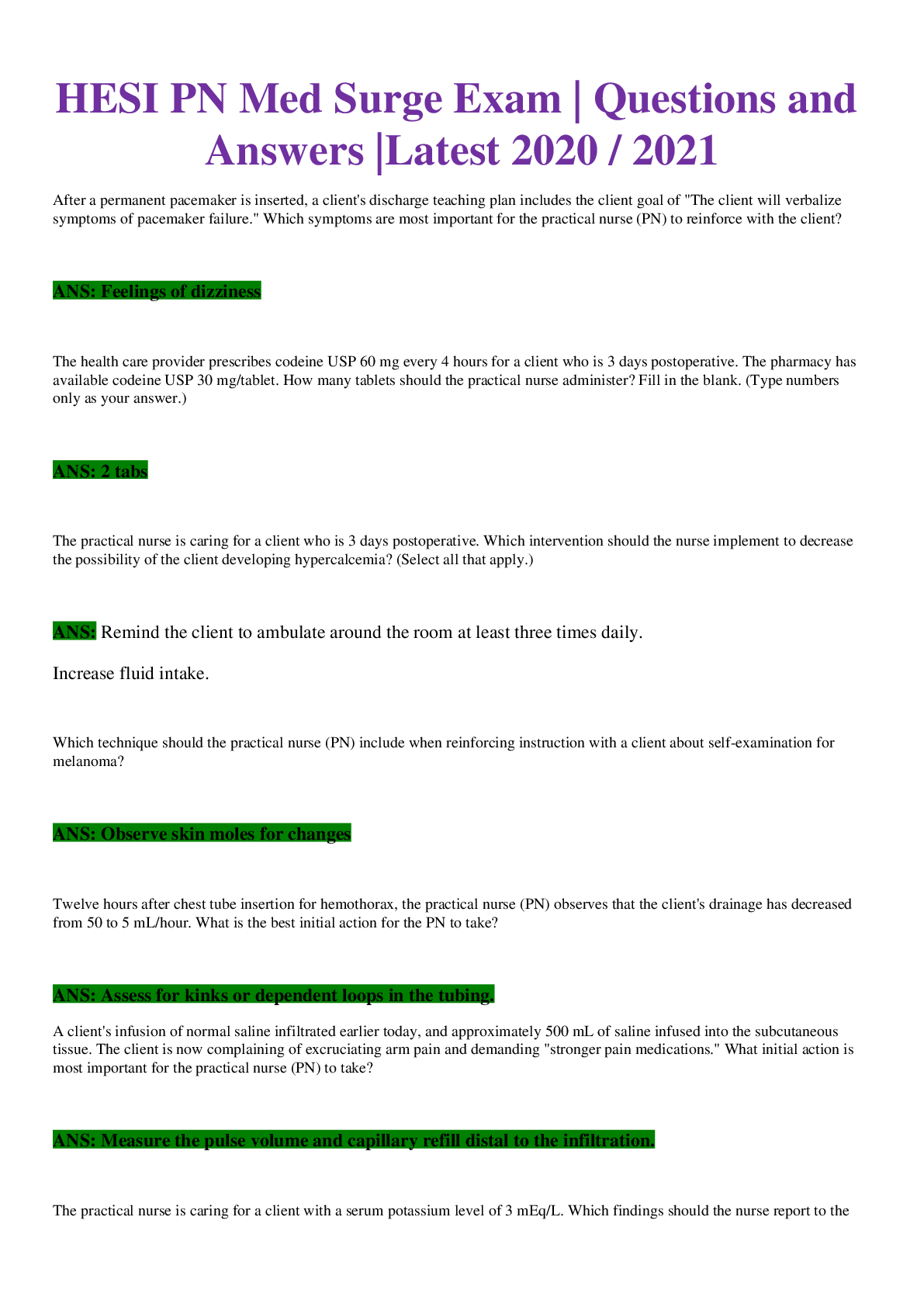
HESI PN Med Surge Exam | Questions and Answers |
HESI PN Med Surge Exam | Questions and Answers |Latest 2020 / 2021 1. After a permanent pacemaker is inserted, a client's discharge teaching plan includes the client goal of "The client will verbaliz...
By nurse_steph , Uploaded: Dec 12, 2020
$12
*NURSING> HESI MED SURG > HESI RN V1-V7 Exit Exam Practice Questions and Answers _Verified Answers. (All)

HESI RN V1-V7 Exit Exam Practice Questions and Answers _Verified Answers.
HESI RN V1 - V7 Exit Exam HESI Review over 800 QUESTIONS-2020 Latest Update Questions and Answers/HESI Review over 800 QUESTIONS-2020 Latest Update Questions and Answers/2020 / 2021 latest update
By succeeded , Uploaded: Nov 20, 2020
$29
*NURSING> HESI MED SURG > HESI Med surg EXIT EXAM Updated (2022-2023) Test Bank. (All)
 Test Bank.png)
HESI Med surg EXIT EXAM Updated (2022-2023) Test Bank.
1. Following discharge teaching, a male client with duodenal ulcer tells the nurse the he will drink plenty of dairy products, such as milk, to help coat and protect his ulcer. What is the best foll...
By A+ Grades , Uploaded: Nov 03, 2022
$20
*NURSING> HESI MED SURG > HESI RN Medical Surgical Med Surg 2023 V1. Complete Real/Captured Exam. 55 Q&A (All)
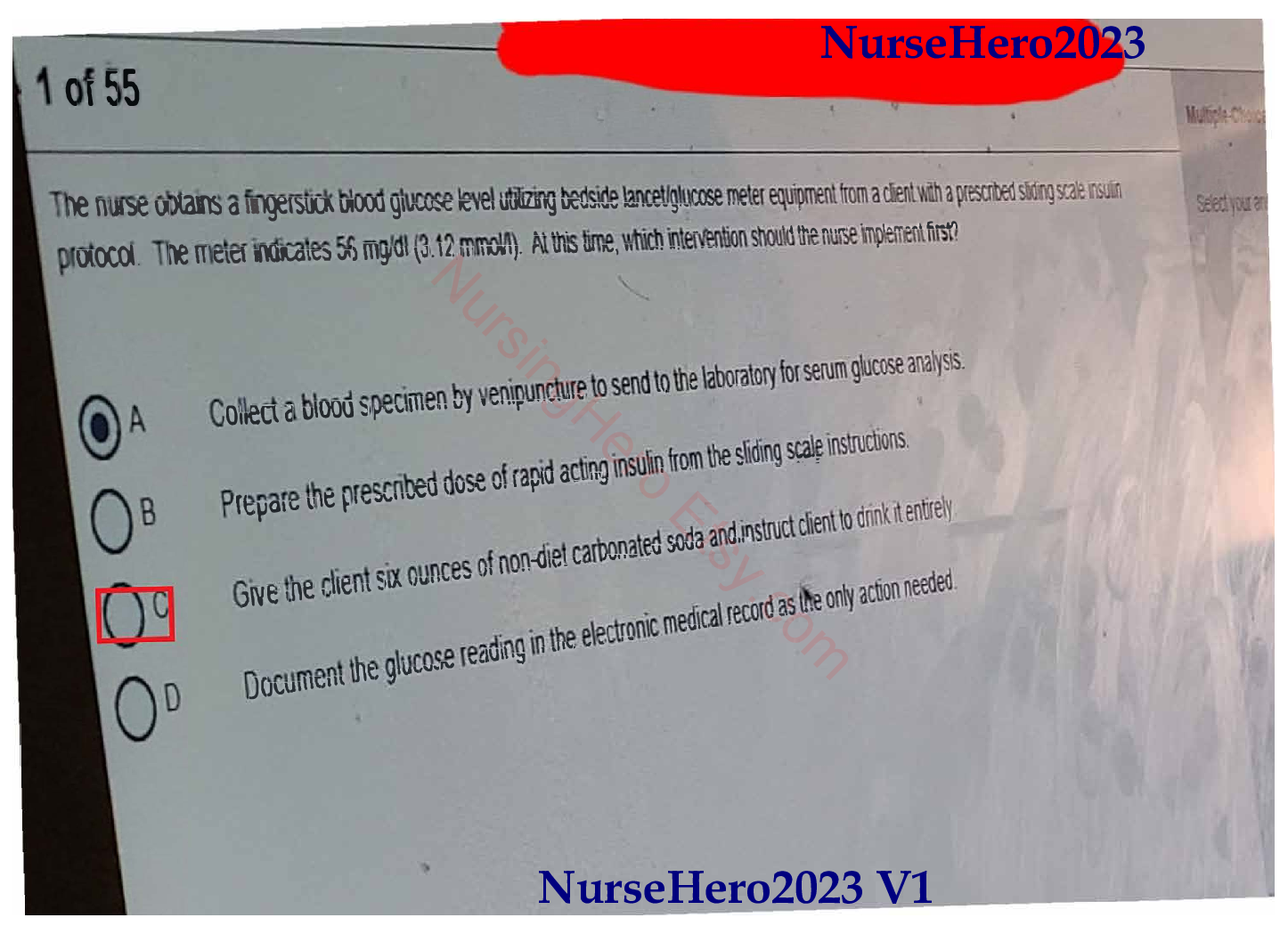
HESI RN Medical Surgical Med Surg 2023 V1. Complete Real/Captured Exam. 55 Q&A
This is a PDF file that has 55 questions of HESI RN Medical Surgical Nursing 2023 V1 It is a good way to review your study by doing these types of questions. I am sure that it will help you even if y...
By NursingHero , Uploaded: May 16, 2021
$22
*NURSING> HESI MED SURG > HESI RN MED-SURG Exam Dumps. Over 500 Q&A (All)

HESI RN MED-SURG Exam Dumps. Over 500 Q&A
HESI RN MED-SURG Exam Dumps. THIS DOCUMENT CONTAINSTHIS DOCUMENT CONTAINS HESI RN MED SURG 2021.QUESTIONS AND ANSWERS.VERIFIED 100% CORRECT QUESTIONS AND ANSWERS 2021 HESI RN MED SURG 2021.QUESTIONS A...
By CHRIS , Uploaded: Apr 03, 2021
$19.5
*NURSING> HESI MED SURG > HESI MED SURG 2018 MEDSURG 55 QUESTIONS RN V1 (All)
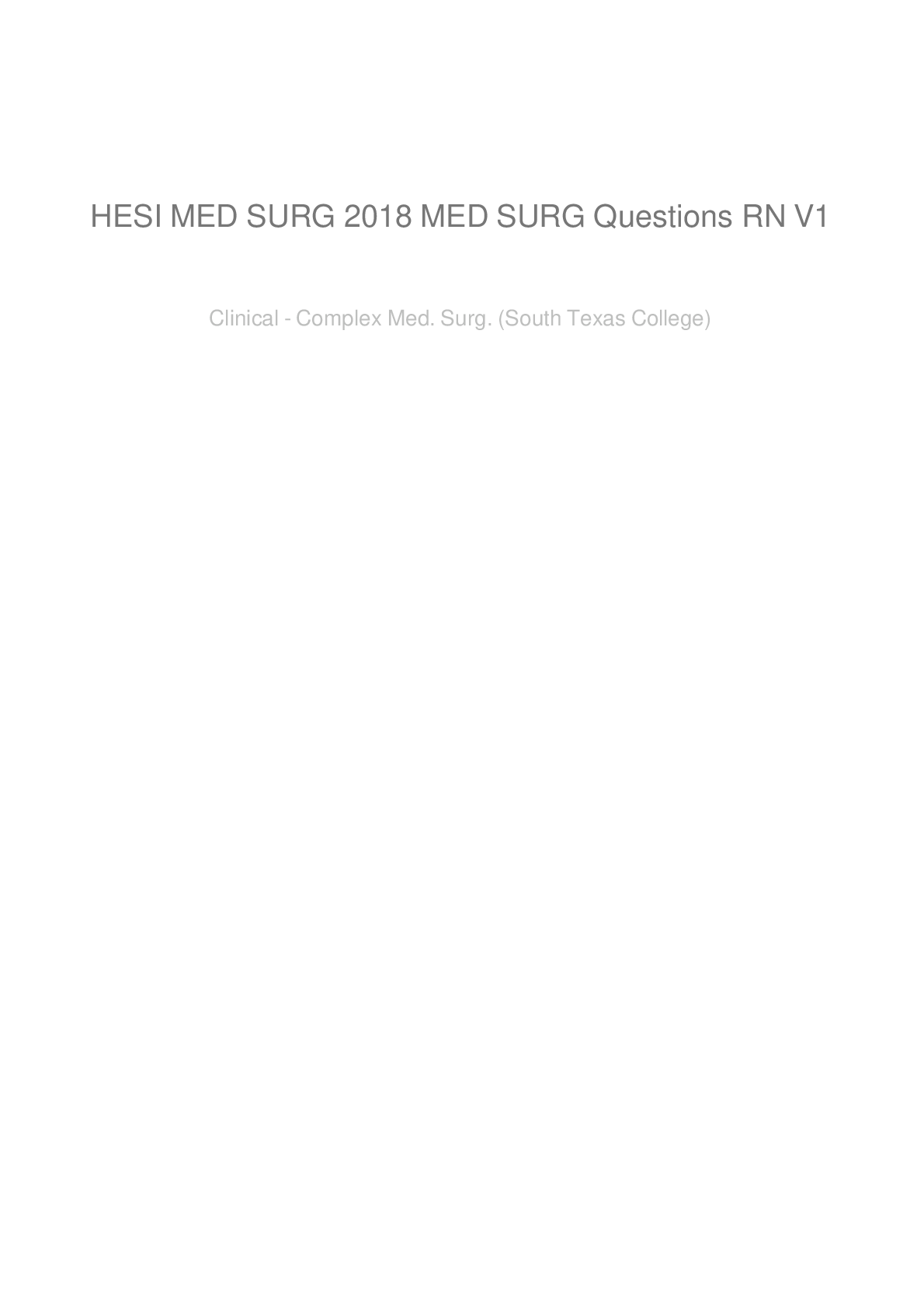
HESI MED SURG 2018 MEDSURG 55 QUESTIONS RN V1
HESI MED SURG 2018 MEDSURG 55 QUESTIONS RN V1
By ACADEMICTUTORIAL , Uploaded: Nov 29, 2021
$4.5
*NURSING> HESI MED SURG > HESI PN MED SURG PROCTORED EXAM BUNDLE (14 VERSIONS) Complete Exam Combination in 400 Pages. (All)
.png)
HESI PN MED SURG PROCTORED EXAM BUNDLE (14 VERSIONS) Complete Exam Combination in 400 Pages.
HESI PN MED SURGE PROCTORED EXAM (14 LATEST VERSIONS, 2021)HESI PN MED SURGE PROCTORED EXAM (14 LATEST VERSIONS, 2021)HESI PN MED SURGE PROCTORED EXAM (14 LATEST VERSIONS, 2021)HESI PN MED SURGE PROCT...
By NurseGrade , Uploaded: Nov 26, 2021
$35.5
*NURSING> HESI MED SURG > MED-SURG | HESI EXIT RN EXAM COMPLETE NEW VERSION AUTHENTIC 2020 | Hondros college of Nursing/(100 % CORRECT) (All)
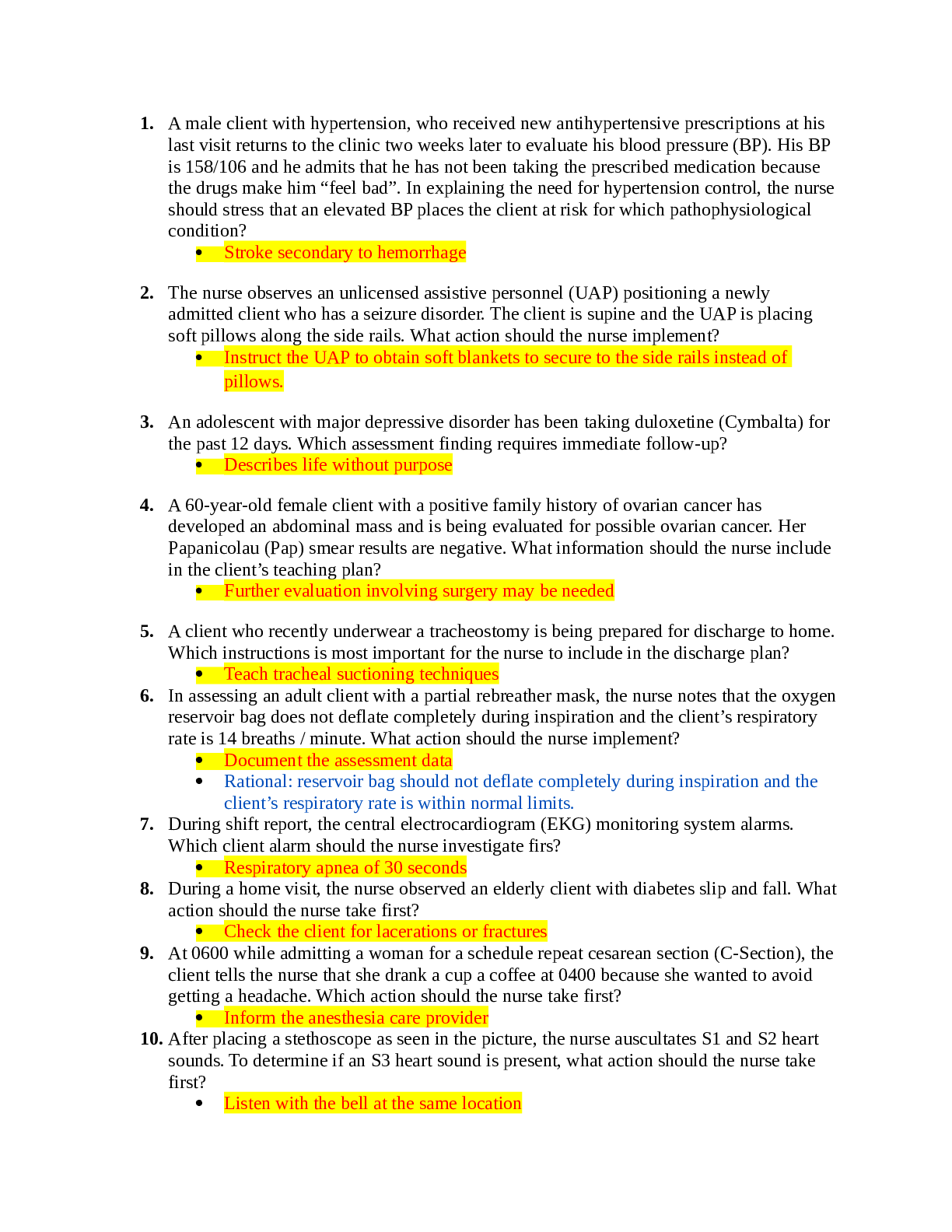
MED-SURG | HESI EXIT RN EXAM COMPLETE NEW VERSION AUTHENTIC 2020 | Hondros college of Nursing/(100 % CORRECT)
MED-SURG | HESI EXIT RN EXAM COMPLETE NEW VERSION AUTHENTIC 2020 | Hondros college of Nursing/(100 % CORRECT)
By A+ Solutions , Uploaded: Feb 22, 2021
$12.5
*NURSING> HESI MED SURG > MEDSURG_HESI.West Coast University NURSING BSN (All)
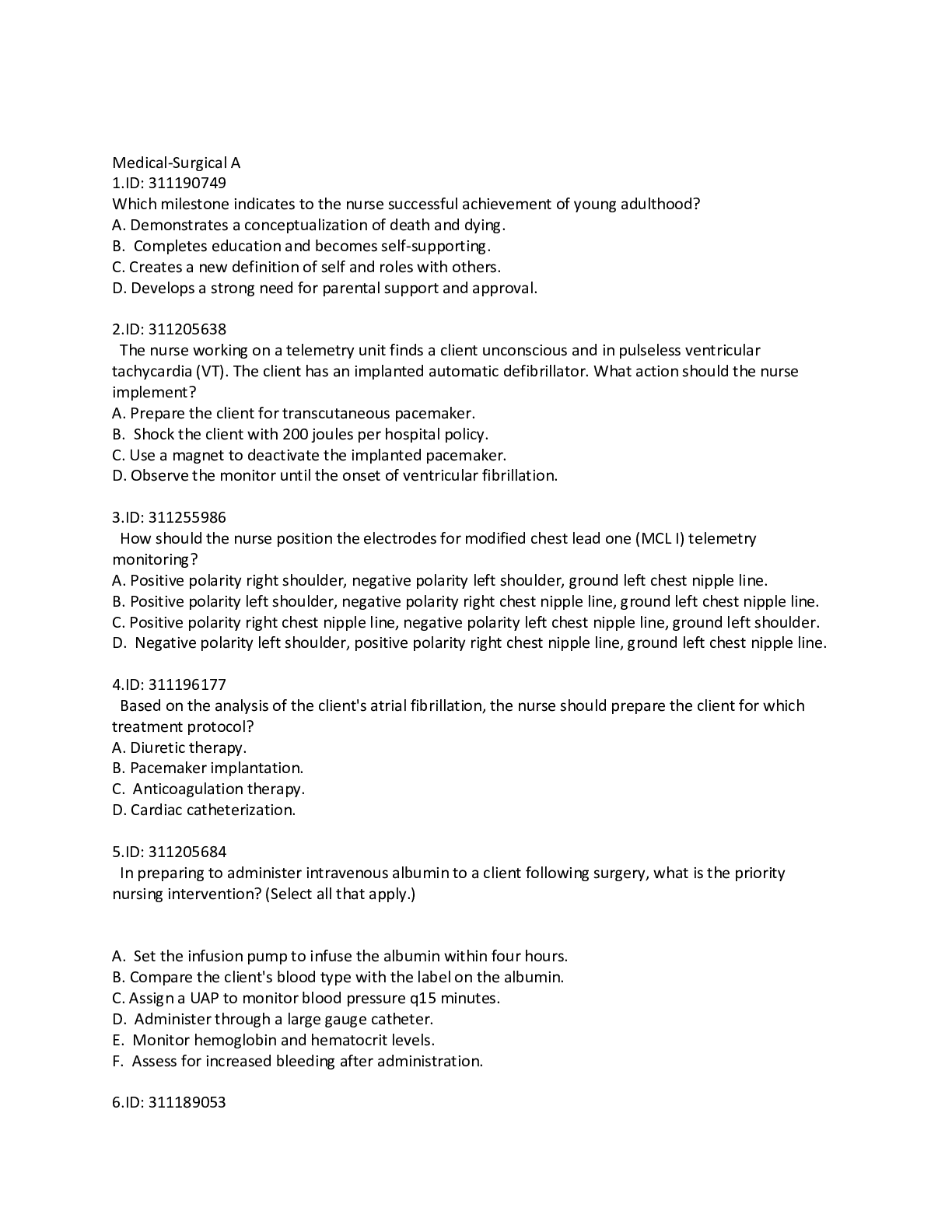
MEDSURG_HESI.West Coast University NURSING BSN
Medical-Surgical A 1.ID: 311190749 Which milestone indicates to the nurse successful achievement of young adulthood? A. Demonstrates a conceptualization of death and dying. B. Completes education...
By Dr Medina Reed , Uploaded: Mar 30, 2022
$15
*NURSING> HESI MED SURG > Med surg HESI EXIT EXAM Updated (June 2022) Test Bank.pdf (All)
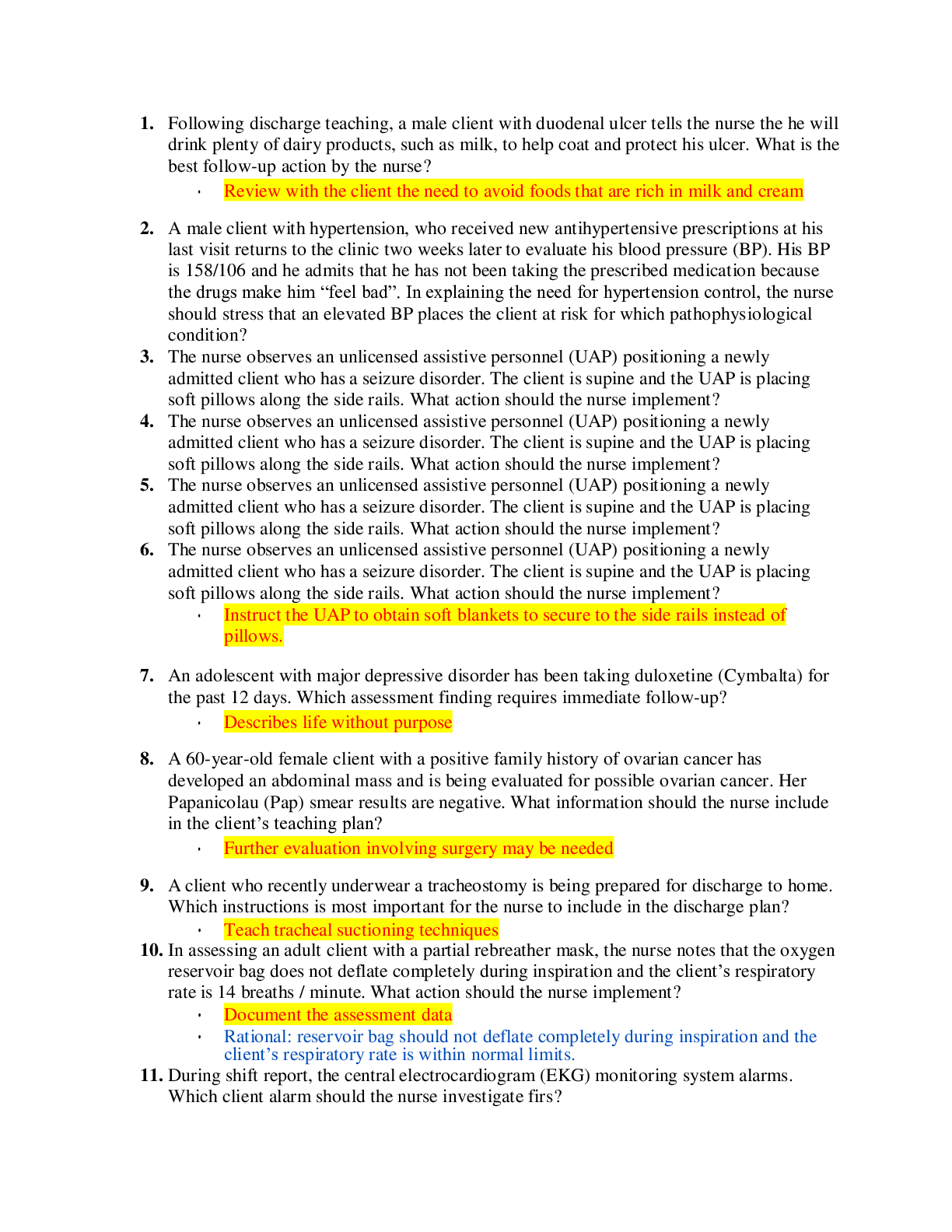
Med surg HESI EXIT EXAM Updated (June 2022) Test Bank.pdf
Med surg HESI EXIT EXAM Updated (June 2022) Test Bank.pdf 1. Following discharge teaching, a male client with duodenal ulcer tells the nurse the he will drink plenty of dairy products, such as milk,...
By Professor Lynne , Uploaded: May 11, 2022
$14
Document information
Connected school, study & course
About the document
Uploaded On
Sep 02, 2020
Number of pages
13
Written in
Additional information
This document has been written for:
Uploaded
Sep 02, 2020
Downloads
0
Views
123






